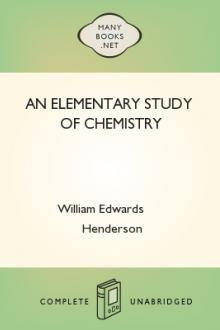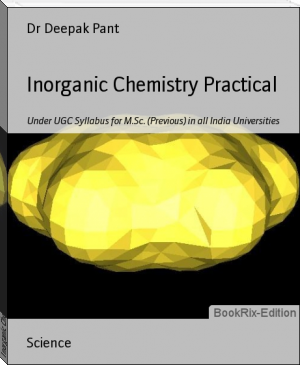An Elementary Study of Chemistry, William McPherson [icecream ebook reader txt] 📗

- Author: William McPherson
- Performer: -
Book online «An Elementary Study of Chemistry, William McPherson [icecream ebook reader txt] 📗». Author William McPherson
Stannous chloride 372
Starch 415
Stassfurt salts 287
Stearic acid 407
Stearin 409
Steel 345
alloys 348
properties 347
tempering of 348
tool 347
Stibine 251
Stibnite 250
Stoneware 336
Strontianite 312
Strontium 312
hydroxide 312
nitrate 312
Structural formulas 119
Structure of compounds 119
Strychnine 419
Substitution 70
Sugars 412
cane 412
fruit 415
grape 414
milk 414
Sulphates 159
Sulphides 148
Sulphites 152
action of acids on 150
Sulphur 143
allotropic forms 144
chemical properties 145
comparison with oxygen 161
dioxide 149
preparation 149
properties 150
extraction 143
flowers of 143
occurrence 143
oxides 149
physical properties 144
trioxide 152
uses 146
varieties 144
Sulphuric acid 154
action as an acid 157
action on metals 157
action on organic matter 158
action on salts 158
action on water 158
fuming 155
manufacture 154
oxidizing action 157
plant 156
properties 157
salts 159
Sulphuric anhydride 153
Sulphurous acid 151
Superphosphate of lime 246
Sylvine 288
Symbols 11
Synthesis 40
Table, alkali metals 274
alkaline-earth metals 300
alloys of copper 359
aqueous tension Appendix B
atomic weights Appendix A
chlorine family 174
composition of earth's crust 10
composition of fuel gases 220
constants of elements Appendix B
copper family 356
elements Appendix A
gold and platinum metals 390
hydrocarbons 399
magnesium family 316
manganese and chromium 379
periodic arrangement 168
phosphorus family 238
silicon family 257
solubility of gases in water 95
solubility of salts 96
solubility of salts at different temperatures 97
tin and lead 370
weights of gases Appendix B
Talc 321, 336
Tartar emetic 408
Tartaric acid 408
Tellurium 161
Temporary hardness 309
Ternary acids 113
salts 114
Tetraboric acid 265
Thallium 327
Theory, atomic 61
definition 64
value of 64
Thermite 331
Thio compounds 282
Thiosulphates 159
Thiosulphuric acid 159
Thorium 377
Tin 370
block 371
compounds 372
crystals 372
family 370
foil 371
metallurgy 370
plate 371
properties 371
uses 371
Titanium 257, 264
Topaz 331
Triad families 166
Tungsten 388
Type metal 253, 375
Uranium 388
Valence 116
a numerical property 116
and combining ratios 118
and equations 120
and formulas 120
and periodic groups 162
and structure 118
definition 116
indirectly determined 117
measure of 117
variable 117
Vaseline 400
Venetian red 349
Verdigris 407
Vermilion 363
Vinegar 406
Vitriol, blue 361
green 350
oil of 154
white 324
Volume and aqueous tension 25
and pressure 24
and temperature 23
of combining gases 194
Water 40
a compound 40
and disease 49
catalytic action of 154
chalybeate 351
chemical properties 53
composition 47
composition by volume 44
composition by weight 47
dissociation of 210
distillation of 50
electrolysis of 41, 103
filtration of 51
gas 219
hard 309
historical 40
impurities in 48
in air 87
mineral 49
occurrence 48
of crystallization 54, 75
physical properties 53
purification of 50
qualitative analysis 41
quantitative analysis 42
river 49
sanitary analysis 50
self-purification 53
softening of 310
standard substance 55
synthesis 43
uses of 55
Weights, atomic 65
Welsbach mantles 219, 377
Whisky 404
Wine 404
Witherite 312
Wood alcohol 402
distillation 402
Wood's metal 254
Xenon 80
Yeast 403
Zinc 321
alloys of 323
blende 321
chloride 325
flowers of 322
metallurgy 321
occurrence 321
oxide 324
sulphate 324
sulphide 325
white 324
Zymase, 403
ANNOUNCEMENTS AN ELEMENTARY STUDY OF CHEMISTRY
By WILLIAM McPHERSON, Professor of Chemistry in Ohio State University, and WILLIAM E. HENDERSON, Associate Professor of Chemistry in Ohio State University.
12mo. Cloth. 434 pages. Illustrated. List price, $1.25; mailing price, $1.40
This book is the outgrowth of many years of experience in the teaching of elementary chemistry. In its preparation the authors have steadfastly kept in mind the limitations of the student to whom chemistry is a new science. They have endeavored to present the subject in a clear, well-graded way, passing in a natural and logical manner from principles which are readily understood to those which are more difficult to grasp. The language is simple and as free as possible from unusual and technical phrases. Those which are unavoidable are carefully defined. The outline is made very plain, and the paragraphing is designed to be of real assistance to the student in his reading.
The book is in no way radical, either in the subject-matter selected or in the method of treatment. At the same time it is in thorough harmony with the most recent developments in chemistry, both in respect to theory and discovery. Great care has been taken in the theoretical portions to make the treatment simple and well within the reach of the ability of an elementary student. The most recent discoveries have been touched upon where they come within the scope of an elementary text. Especial attention has been given to the practical applications of chemistry, and to the description of the manufacturing processes in use at the present time.
EXERCISES IN CHEMISTRY. By WILLIAM McPHERSON and WILLIAM E. HENDERSON. (In press.) GINN & COMPANY PUBLISHERS A FIRST COURSE IN PHYSICSBy ROBERT A. MILLIKAN, Associate Professor of Physics, and HENRY G. GALE, Assistant Professor of Physics in The University of Chicago
12mo, cloth, 488 pages, illustrated, $1.25
A LABORATORY COURSE IN PHYSICS FOR SECONDARY SCHOOLSBy ROBERT A. MILLIKAN and HENRY G. GALE 12mo, flexible cloth, 134 pages, illustrated, 40 cents
This one-year course in physics has grown out of the experience of the authors in developing the work in physics at the School of Education of The University of Chicago, and in dealing with the physics instruction in affiliated high schools and academies.
The book is a simple, objective presentation of the subject as opposed to a formal and mathematical one. It is intended for the third-year high-school pupils and is therefore adapted in style and method of treatment to the needs of students between the ages of fifteen and eighteen. It especially emphasizes the historical and practical aspects of the subject and connects the study very intimately with facts of daily observation and experience.
The authors have made a careful distinction between the class of experiments which are essentially laboratory problems and those which belong more properly to the classroom and the lecture table. The former are grouped into a Laboratory Manual which is designed for use in connection with the text. The two books are not, however, organically connected, each being complete in itself.
All the experiments included in the work have been carefully chosen with reference to their usefulness as effective classroom demonstrations.
GINN AND COMPANY PUBLISHERS APPENDIX A LIST OF THE ELEMENTS, THEIR SYMBOLS, AND ATOMIC WEIGHTSThe more important elements are marked with an asterisk
O = 16





Comments (0)